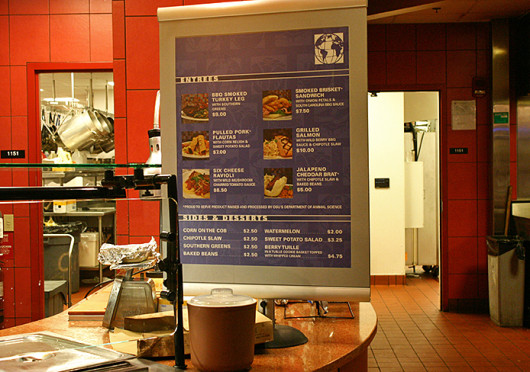
Prices are displayed on a menu at Union Market. The prices of some food options increased Fall Semester..
Credit: Shahed Al-Asadi
Ohio State students’ wallets might need to stretch a little more for that burrito at Burritos as the prices of some campus dining products experienced a jump this year.
Certain product prices changed based on a variety of factors, but there was not an across-the-board increase, according to Zia Ahmed, senior director of Dining Services.
“We don’t really do any overall price increases. We make adjustments to our prices when and where it’s necessary,” Ahmed said. “Some item prices may have gone down because of whatever reasons, and the other items we needed to increase prices.”
Dining Services adjusts prices in order to ensure it’s not losing money, but not to make a profit, Ahmed said.
“We don’t really have profits, so it’s based on where we needed to be in order to make our food costs,” he said.
One item that experienced that change was Burritos’ burritos, which now cost $7.50 versus their previous $6 price tag.
The factors that play into whether or not a price changes are consumer price index for food, producer price increases and predictions of price changes by people in the food industry, Ahmed said.
“In some cases, price adjustments may be made because we know that price might not be fluctuating right now, but it has a very good chance of fluctuating in the future because of some things that have happened before,” he said.
Even so, some students are less than pleased with the on-campus dining prices.
“Some items are really expensive and the prices don’t match up sometimes,” said Allison Rudolph, a first-year in business. “You’ll (buy) two granola bars, and it’ll be $2 (each). So you have an extra dollar (to make a full $5 block) that you’re still using, but you’re not spending.”
Last fall, OSU switched from meal plan “swipes” on the quarter system to “blocks” with semesters, initially offering plans of 450 and 600 blocks. These block plans, however, left many students with an excess of blocks after Fall Semester 2012. OSU gave students a $3 refund per block in BuckID cash for Fall Semester only in response to the excess, also adding a 350-block plan option for Spring Semester 2013.
For the 2013-2014 school year. OSU did away with the 600-block plan and added plans offering weekly block allotments of either 25 or 20. OSU also split the “unlimited” meal plan into two options, giving students the choice of a meal plan that offers either 10 or four blocks per week in addition to unlimited access to the three Traditions dining locations on campus.
Haley Sferra, a third-year in marketing, said some students are hesitant to buy a university dining plan because of the high prices.
“I’d rather spend the $6 to buy food that I can get anywhere around here,” Sferra said.
For students with an OSU meal plan on the block system, higher prices could mean less efficient usage of their blocks.
Phil Kebe, a first-year in business, noted oftentimes items will come out to $6 or a similar price, inciting students to buy more in order to use two full blocks.
“It kind of makes you spend more,” Kebe said.
Ahmed, however, stands by Dining Service’s item-based pricing system.
“We don’t follow (an across-the-board increase) model because it’s not a very friendly guest satisfaction model, number one,” Ahmed said, “and number two, it’s much more effective when you actually increase where it’s needed to be increased and adjust where it needs to be adjusted.”


